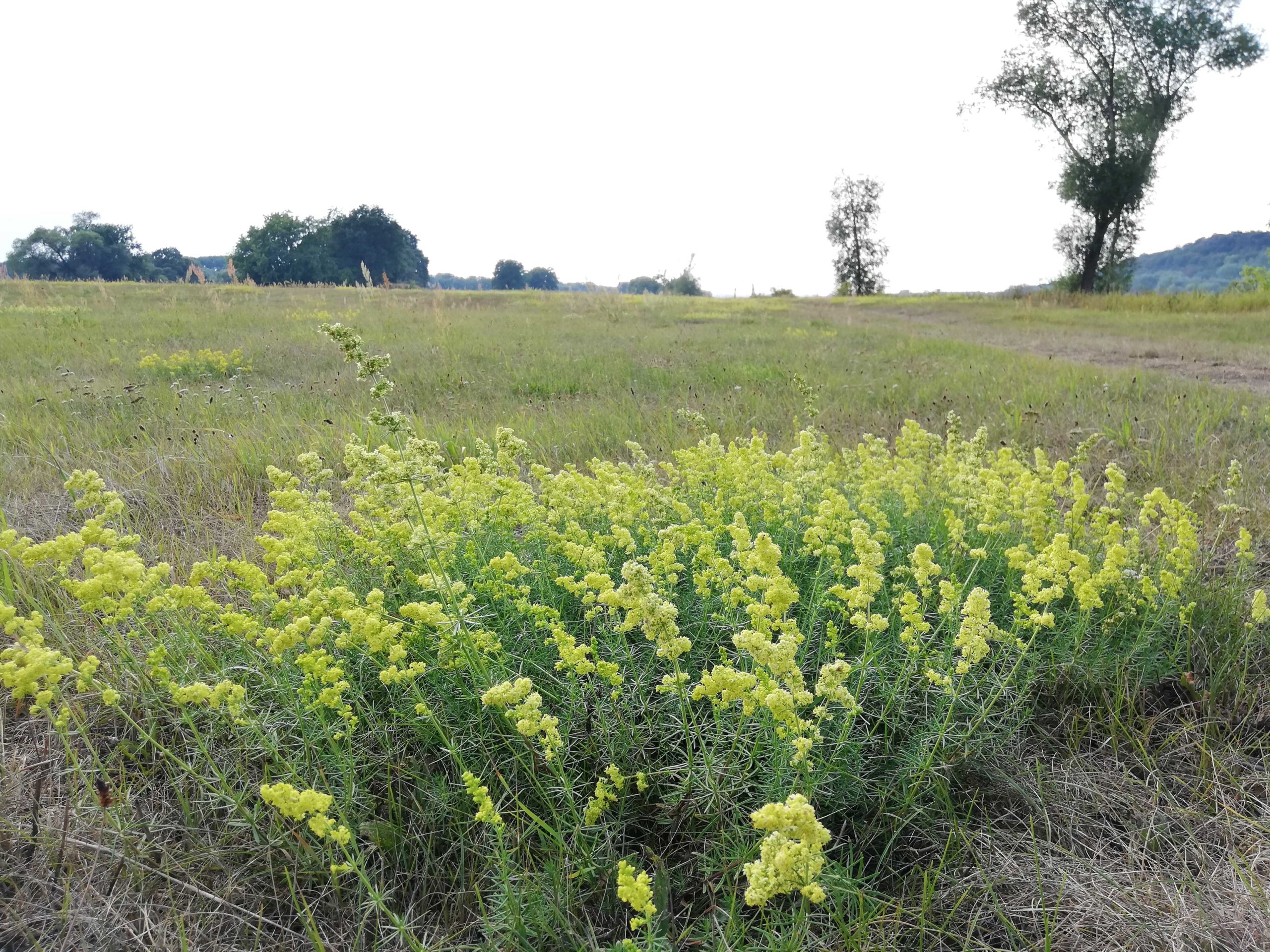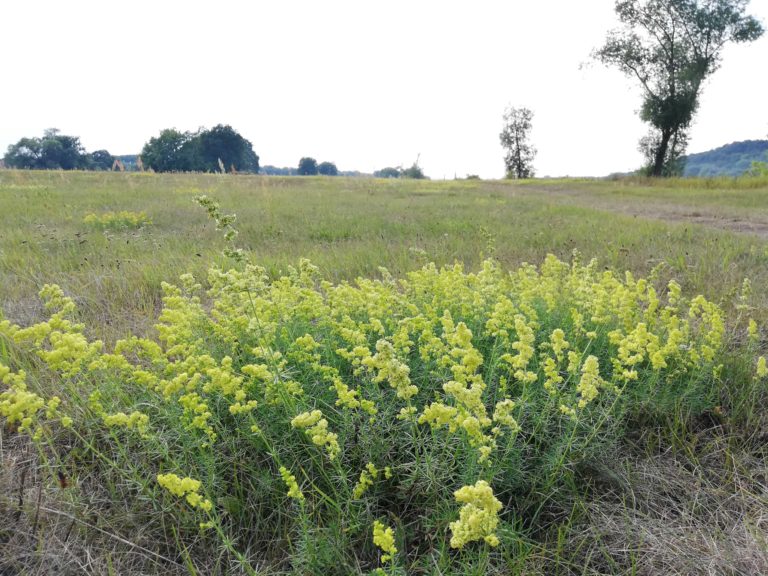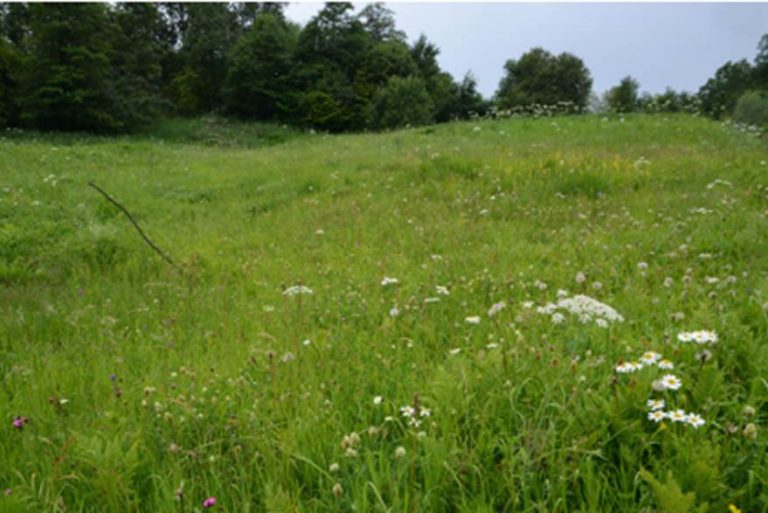This blog article was originally published by Mareike Andert on the blog of the Institute for Social-Ecological Systems (SESI) at Leuphana University, which you can find here.
Vicky Temperton, affiliated with SESI and full member of the Institute of Ecology, talks in this blog post about her passion for grasslands and how grasslands can contribute to mitigating and adapting to the climate crisis. Recently she has been nominated to the advisory board on natural climate solutions to advise the ministry of the environment and the German government with her expertise. She did her PhD on trees under climate change conditions, but then switched to research grasslands, because she sees in this field more potential for the sustainability crises.
Vicky, you are dedicating much research and time to grasslands. Why?
There is a personal and a broader answer. Personally, I grew up in Luxembourg, right next to the grasslands, mainly meadows but also pastures with cows. And I also grew up next to forest. For me, a natural landscape is a biodiverse landscape: species rich grasslands and species rich forests. For example, my neighbour, she was from Italy, and she would go out with me into the grassland, and we’d pick the champignons. I also played football in them. So, I kind of got these relational values, those connection to grasslands from a very early age. Grassland was just the place where I lived, and it was and is massively important to me.
What is the broader answer to your passion about grasslands?
I did my PhD on trees, but then after that, my first postdoc in Jena was on degraded grassland and how it was recovering after pollution from the biggest fertilizer factory for phosphorus in the German Democratic Republic. Grasslands cover about a third to 40% of the earth. So, they are everywhere. And they contribute enormous amounts of biodiversity, or at least they used to, and they contribute enormously to the functioning of systems and landscapes and to their ecosystem services.
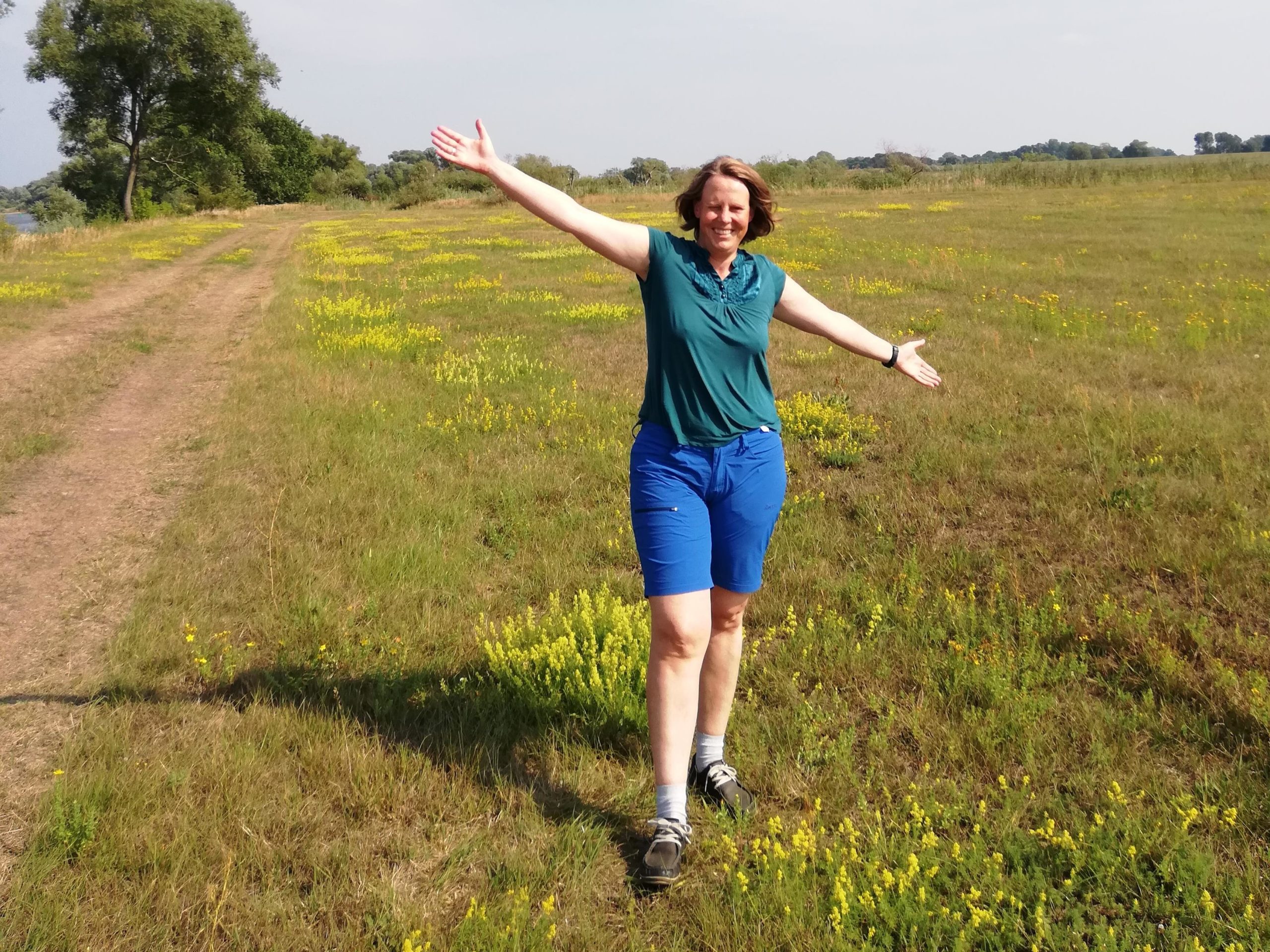
Why are grasslands so important?
Most of the plant species that we’re currently losing (the ones on the red list of endangered species), for example, in Germany, are species which live in grasslands. Our study (Staude et al. 2023) looked at species on the Red List and found out that 82% of the species on the Red List need high light and 61% need low nitrogen. Before we looked at the data, I would have said that the main driver for biodiversity loss was the nitrogen. But it’s actually even more the light. This was really shocking and eye opening for me.
Humans and other animals have lived with grasslands for millennia. Recent research has found out that this whole idea that the whole landscape before humans, was just forest is probably not correct. With more and larger herbivores around during the period since the last ice age, the co-called “Temperate Forest Biome” probably resembled wood pastures and woodland as well as thicker forest in many places. Pearce et al. (2023) have shown with their recent pan-European study of pollen evidence that the openness and darkness of what we call forest has been very dynamic over time. This affects what we consider to be the best reference conditions or goal for conservation or restoration.
Grasslands are important for people. There’s now a global grasslands dialog platform, run by the WWF (World Wide Fund For Nature) that I’m a member of. We’re pushing this because we feel like this biome is being disregarded and not adequately given the attention it deserves considering it covers one third of the planet and is a baseline for many pastoralist cultures as well as rangeland communities. People do not see it or value it enough and this is visible in current science policy. It’s almost analogous with our society only considering men, not women or other genders, yet other genders make up a large proportion of society.
Do you have an example for the disregarding of grasslands?
The Aktion Natürlicher Klimaschutz (ANK) of the German government is the largest environmental funding ever coming from the German parliament, and yet grasslands are not explicitly positioned in the programme description: analagous to their “disappearance” in the words agriculture, rangeland, or farmland, pasture, they are implicitly included in the chapter on peatlands (but these habitats are only one form of grassland, albeit the one that can store by far the most carbon than any habitat) and implicitly included in Urban Green Spaces, as we as well as the chapter on Soils. No-one deemed them important enough to have their own chapter – this could be called grassland blindness. I do find myself wondering, why we are so grassland blind as a society, when we know that to bend the biodiversity curve in Germany (and elsewhere), we would do well to invest a lot more in recreating species-rich grasslands.
To me, a grassland really involves people living in it or around it, often with their livestock or with wild animals, and managing it because otherwise you can’t have a grassland, you can’t keep it open, unless it’s super dry or super wet, or you reintroduce large herbivores.
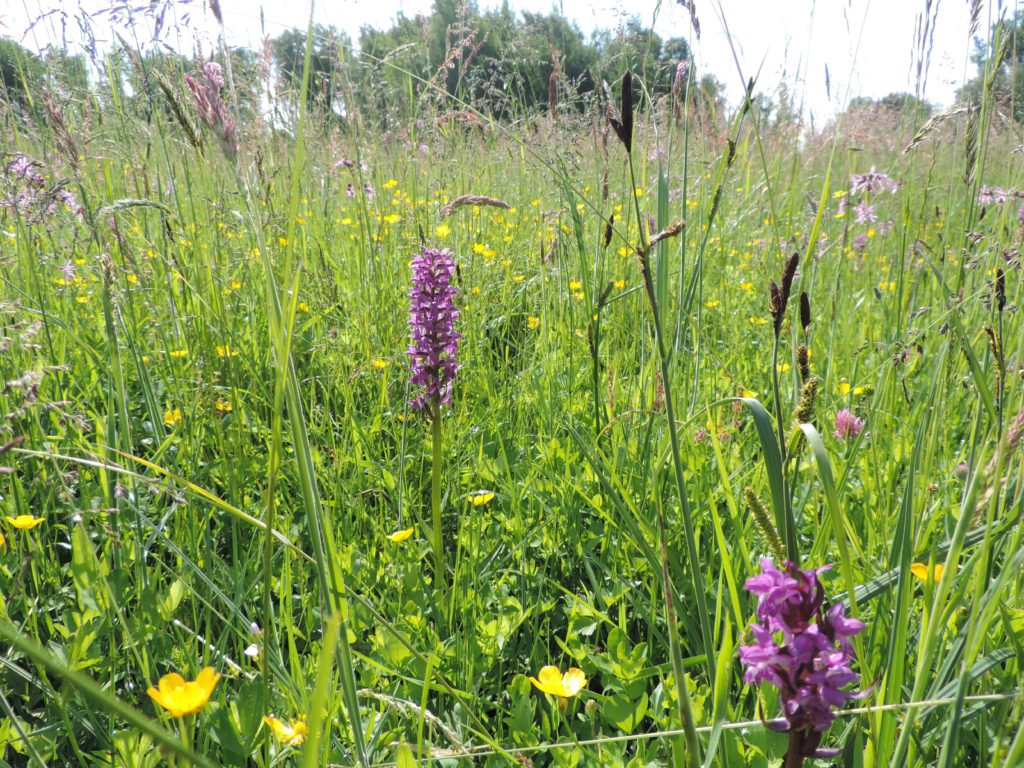
That means, the perception about grasslands is also really about, if you see humans as part of nature or if you see them separately…
… yes, and the ironic thing is, people talk about forest as the only natural, but then they’re talking about something like a pine monoculture. In what way is this natural? That’s completely absurd. But we seem to have this ingrained view that everything should be forest. And that’s the natural state, and that grasslands are essentially degraded forests. But we have forgotten the large herbivores. Large herbivores were much more dominant in the past and therefore it was a much more open landscape. Also, fire keeps landscapes open.
This idea of what’s natural is very important. People often think that anything that was natural was the forest. Whereas to me it’s both, it’s going back to the Luxembourg story. Grasslands have been around even before humans, as a key component of the landscape (Pearce et al. 2023).
Forests are seen as important for climate change mitigation. What about grasslands?
There’s a big focus on the trees and, planting trees. But moorland, peatland – they’re grasslands – store way more carbon than the forest. Luckily now Germany has kind of understood this. And so, I’ve just joined the advisory board for the German government on natural climate solution, where peatlands are a major focus, as well as forests, urban spaces, soils, and the marine environment.
If you restore peatlands right and you have the water table at the right level, you can store enormous amounts of carbon. Additionally, a study from California (Dass et al. 2018) found that with business-as-usual climate scenarios, the grasslands will be the only remaining habitat that remains a carbon sink, and does not become a net source. Perhaps they have garnered less attention as they are often considered degraded forests, but studies such as Pearce et al. or the Wood Pasture Hypothesis do not align with this view.
When people are just planting trees, they’re not thinking about that there will be more fires because of climate change or more successful pest attacks as the trees weaken in climate change. The huge jarrah trees (Eucalyptus regnans) in Western Australia are keystone species for this wonderful habitat that has been successfully restored after mining, but the large trees are starting to die after temperatures of over 40 degrees in recent months. We need to factor these drivers of change into our response to global change. We are no longer living in a relatively stable world in terms of abiotic conditions, so when striving to mitigate climate change we need to consider the role of the current already changing environmental conditions. Besides, trees often die anyway because they don’t establish very well (usually around 30% die after planting unless very good care is taken). After a fire, the carbon has gone again into the atmosphere.
Therefore, we need to get that carbon below ground, whether it’s in a forest, a moorland, a peatland or a savanna. Grasslands have a lot of plant materials, roots, below the ground which is very good for carbon storage especially longer-term storage. I think this is the research that’s really important to do now: Find out, when grasslands can store carbon and for how long, and compare this across different habitat types. To what extent we have biodiversity and carbon and when not, and which management actions create which outcomes.
What are you exactly researching?
The big question in our Grassworks project is, what leads to success in grassland restoration. We have three regions: North, East and South of Germany with different partners and we’ve looked at over 180 already restored sites. It was a crazy job because, it took two years to do the field work. We’re doing it from an ecological, social and social-ecological perspective. We’re looking at the economics of grasslands, the value systems and leverage points and vector for change as well as the ecological outcomes of restoration. Some of the sites had as a previous land use grassland, some were crops, some were restored for a long time, some for less time. We have these different factors and then it’s a bit like a huge landscape experiment across the whole of Germany. We’re finally getting the results now, and I can’t tell you too much yet, except for the vegetation, it is looking like the best option for ecological success in terms of plants is either to use direct hay transfer methods, or to sow wild seed mixtures if you want to recreate a meadow, but the answer does depend on which positive reference site you use – and the quality of these positive sites varies strongly across Germany.
The other research I’m working on with grasslands has a lot to do with history: Does it matter who arrives first or who arrives later? It’s called priority effect research. This is very interesting because you wouldn’t really expect it, but it can have a very big effect on productivity and biodiversity when certain plant species establish before others. In this experiment in the Lüneburger Heide, it’s called POEM – Priority Effect Mechanisms – there we sow either the grasses first and then later the other groups like forbs (fancy flowering plants) and legumes (such as clover) or the other way round. And then we also have a simultaneous treatment as normal in current restoration. The timing has an effect on the roots. We found that if you put the legumes, all the forbs first, astonishingly the roots go deeper. And we don’t know why. What we’re trying to find out now how persistent this effect is and whether we keep finding this effect across different experiments. Because if we could recreate this, then you might be able to have grasslands that are more adapted to drought, because they would have deeper roots and so be better adapted to finding water under drought conditions.

What do you want to examine in the future?
I want to go further in this story of biodiversity and carbon storage of grasslands: What leads to better carbon sequestration? How can you get the extra carbon into the soil? Does it stay there? There’s contradictory research at the moment. And what role does biodiversity play in this? Is the most carbon stored in the more biodiverse sites or not? And no one really knows this yet because it’s such a huge and challenging job to analyse this because soils are incredibly heterogeneous. Each area is affected by what was growing on it there in the past. Recent research on soil heterogeneity by the Thünen Institute for Climate Smart Agriculture (the group of Axel Don) is showing that soils can differ surprisingly strongly within a few metres of each other. The rock-based underneath is generally similar. It shows the power of the biota to change the soils.
I also want to expand my work on social-ecological aspects of restoration success. The biggest bottleneck for grassland restoration or biodiversity of grasslands is that they’re not valued enough and there are not yet incentives to maintain ore create new species-rich grasslands, especially for farmers. And so, it is also about the motivation for farmers to create specie rich grassland – giving them money and value from society for doing nature-friendly and carbon friendly farming as a contribution to climate change mitigation and adaptation and bending the biodiversity curve. There isn’t much of an incentive right now.
Once we interviewed farmers in the Lüneburger Heide and asked, what’s keeping you from going for more of these CAP (Common Agricultural Policy) greening programs or getting the subsidies for that kind of thing? We had the hypothesis that the reason why they weren’t doing it was because it’s a lot of bureaucracy. Turns out, no, it’s actually what the others are doing. So, they’re looking at each other and deciding what they do based on their peer group. And this shows that there is a lever or change.
What should politics do?
I’m hoping, that when we finish the Grassworks project, that überswe’ll have some concrete recommendations. I think financial incentives could play a big role, but also the leverage related to connections and relational values, I think if people experience this kind of biodiversity more, if they’re used to it and seeing it in the landscape as well as knowing all the benefits we derive from it, I think then then they’d be more interested in saving or restoring it.
Interview by Mareike Andert
Read more about the topics here:
Dass, Pawlok et al. (2018): Grasslands may be more reliable carbon sinks than forests in California. Environ. Res. Lett. 13 074027. DOI: 10.1088/1748-9326/aacb39.
Pearce, Elena A. et al. (2023): Substantial light woodland and open vegetation characterized the temperate forest biome before Homo sapiens. Sci. Adv. 9. DOI: 10.1126/sciadv.adi9135.
Staude, Ingmar R. (2023): Prioritize grassland restoration to bend the curve of biodiversity loss. Restoration Ecology, 31, 5. DOI: https://doi.org/10.1111/rec.13931
